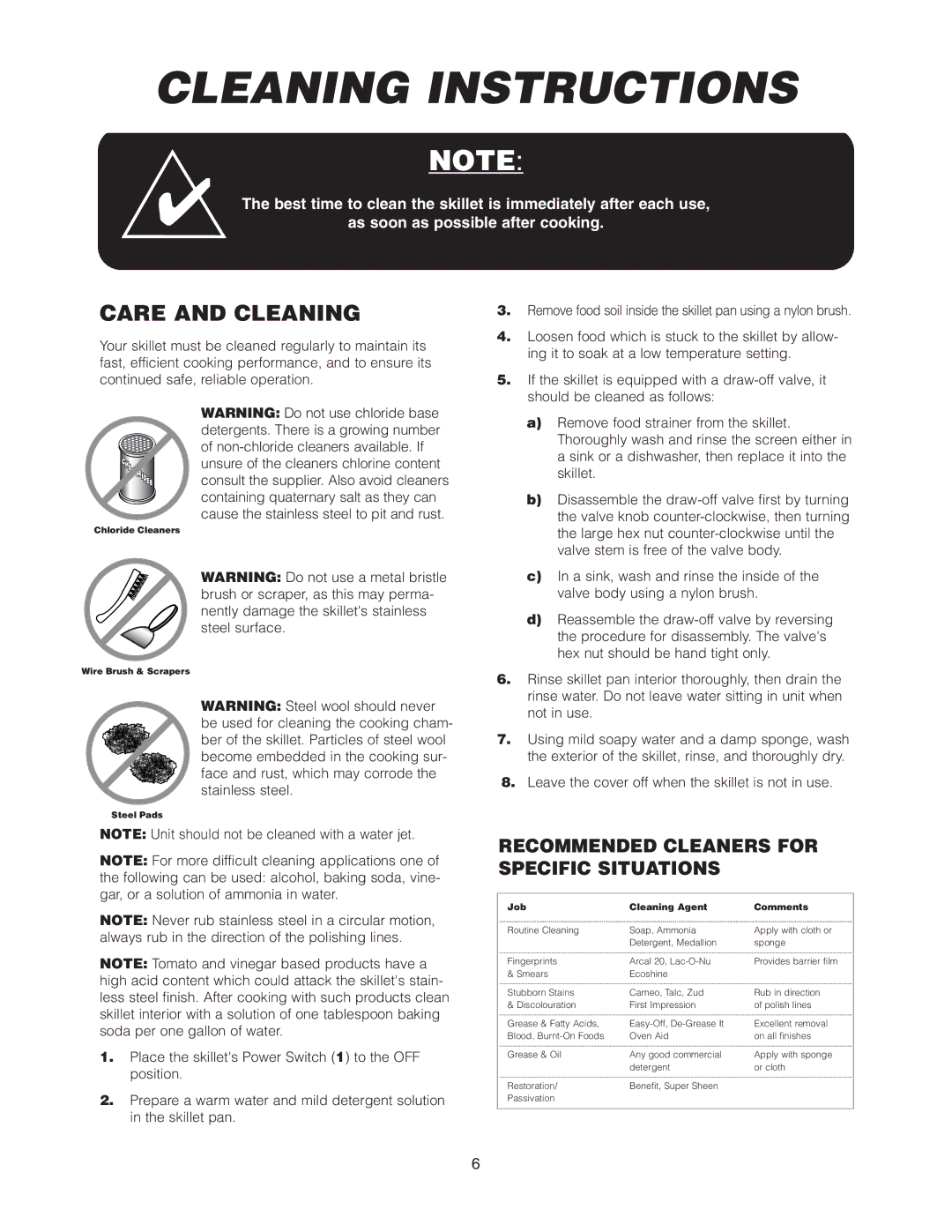
CLEANING INSTRUCTIONS
NOTE:
✔The best time to clean the skillet is immediately after each use,
as soon as possible after cooking.
CARE AND CLEANING
Your skillet must be cleaned regularly to maintain its fast, efficient cooking performance, and to ensure its continued safe, reliable operation.
WARNING: Do not use chloride base detergents. There is a growing number of
Chloride Cleaners
WARNING: Do not use a metal bristle brush or scraper, as this may perma- nently damage the skillet's stainless steel surface.
Wire Brush & Scrapers
WARNING: Steel wool should never be used for cleaning the cooking cham- ber of the skillet. Particles of steel wool become embedded in the cooking sur- face and rust, which may corrode the stainless steel.
3.Remove food soil inside the skillet pan using a nylon brush.
4.Loosen food which is stuck to the skillet by allow- ing it to soak at a low temperature setting.
5.If the skillet is equipped with a
a)Remove food strainer from the skillet. Thoroughly wash and rinse the screen either in a sink or a dishwasher, then replace it into the skillet.
b)Disassemble the
c)In a sink, wash and rinse the inside of the valve body using a nylon brush.
d)Reassemble the
6.Rinse skillet pan interior thoroughly, then drain the rinse water. Do not leave water sitting in unit when not in use.
7.Using mild soapy water and a damp sponge, wash the exterior of the skillet, rinse, and thoroughly dry.
8.Leave the cover off when the skillet is not in use.
Steel Pads
NOTE: Unit should not be cleaned with a water jet.
NOTE: For more difficult cleaning applications one of
the following can be used: alcohol, baking soda, vine- gar, or a solution of ammonia in water.
NOTE: Never rub stainless steel in a circular motion, always rub in the direction of the polishing lines.
NOTE: Tomato and vinegar based products have a high acid content which could attack the skillet's stain- less steel finish. After cooking with such products clean skillet interior with a solution of one tablespoon baking soda per one gallon of water.
1.Place the skillet's Power Switch (1) to the OFF position.
2.Prepare a warm water and mild detergent solution in the skillet pan.
RECOMMENDED CLEANERS FOR SPECIFIC SITUATIONS
Job | Cleaning Agent | Comments |
Routine Cleaning | Soap, Ammonia | Apply with cloth or |
| Detergent, Medallion | sponge |
Fingerprints | Arcal 20, | Provides barrier film |
& Smears | Ecoshine |
|
Stubborn Stains | Cameo, Talc, Zud | Rub in direction |
& Discolouration | First Impression | of polish lines |
Grease & Fatty Acids, | Excellent removal | |
Blood, | Oven Aid | on all finishes |
Grease & Oil | Any good commercial | Apply with sponge |
| detergent | or cloth |
Restoration/ | Benefit, Super Sheen |
|
Passivation |
|
|
|
|
|
6
